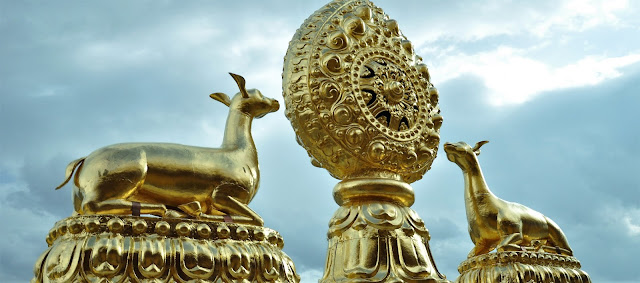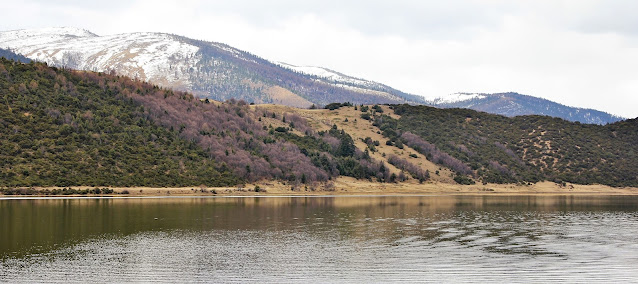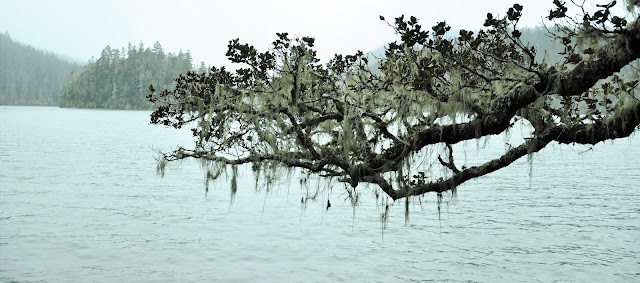
L-R: Teh Soon Shoei behind, Lily Yap, Lim Sok Bee, Ng Peng Kim, Lee Kam Boon, Bernard Lee, Ching Neng Bin on the bus to Shangri-La.
Day 17 (15.04.2013) Lijiang (丽江) to Shangri-La (香格里拉) (Zhongdian (中甸) 180km
After an early breakfast at KFC, we walked to the old long distance bus station to take the bus at 9.30am to Shangri-la. The 180km four hour bus journey took us through the valley and mountains and finally arrived at Shangri-la at 2pm.
On arrival at Shangri-La the last frontier, we all congratulated ourselves for another very successful challenging road journey and truly fulfilled our dreams, especially for Ching Neng Bin. Many thanks to our team leader, Bernard Lee and to all members who have assisted Bernard in so many ways.
After checking into our hotel we had lunch at Feilong Restaurant (飞龙饭店) directly opposite the hotel. We then took three taxis to visit Songzanlin Tibetan Monastery (西藏噶丹松賛林寺) also known as Shangri-La or Little Potala located at 3317m above sea level, the largest Tibetan Monastery in Yunnan. We came back at 6pm and had hotpot dinner at the same restaurant.
Temperature: 3c at night
Sleeping: Bihaiyuntian Business Hotel (碧海云天商业酒店) Shangri-la.

The 180km journey on winding mountain roads from Lijiang to Shangri-la.

Shangri-La is the "Eden in dream" since it first appeared in British novelist James Hilton's Lost Horizon in the 1939, it has been associated with the mystique of a place which could not possibly exist here on Earth.

In Tibetan, Shangri-La means the "sun and moon in heart", an ideal home only found in heaven. The continuous snowy mountains, endless grasslands and rivers, steep and grand gorges, lakes and villages always leave deep impression on visitors.

Shangri-La town centre.

Sleeping: Bihaiyuntian Business Hotel (碧海云天商业酒店) Shangri-La.

We had cheap good lunch at Feilong Restaurant (飞龙饭店) directly opposite Bihaiyuntian Business Hotel.

We had cheap good lunch at Feilong Restaurant (飞龙饭店) directly opposite Bihaiyuntian Business Hotel.

Tibetan Buddhist Monastery is about 5km from the city of Shangri-La.

Getting the bus and entrance tickets to Tibetan Monastery in this Shangri-La new booking office.

Getting the bus and entrance tickets to Tibetan Monastery in this Shangri-La new booking office.

At viewing platform, beginning of 215m boardwalk to Shangri-La Tibetan Buddhist Monastery behind.


Beginning of 215m boardwalk to Shangri-La Tibetan Buddhist Monastery behind.

Almost dried up Lamuyuan Cuo Lake in front of Shangri-La Tibetan Buddhist Monastery behind.

Almost dried up Lamuyuan Cuo Lake in front of Shangri-La Tibetan Buddhist Monastery behind.

Shangri-La Tibetan Buddhist Monastery is situated in an altitude of 3,380 metres (11,090 ft) high.

Walking on the 215m boardwalk to Shangri-La Tibetan Buddhist Monastery.

Walking towards to Shangri-La Tibetan Buddhist Monastery.

L-R: Chew Leng Soon, Lim Cheng Tee, Ching Neng Bin, Lily Yap, Lim Sok Bee, Ng Peng Kim, Bernard Lee (Team Leader), Lee Kam Boon, Grace Ong Siew Hua, Teh Soon Shoei at Songzanlin Tibetan Monastery 西藏噶丹松賛林寺, Shangri-La, China. At an altitude of 3450m, is located in the seat of Diqing Tibetan Autonomous Prefecture, northwest of Yunnan Province, about 200 km from Lijiang with 4 hours’ driving.

Ching Neng Bin at the entrance gate for a 146 steps up to the main hall of Shangri-La Tibetan Monastery.


A 146 steps up to the main hall of Shangri-La Tibetan Monastery.

A 146 steps up to the main hall of Shangri-La Tibetan Monastery.

The upper approach path to the Shangri-La Tibetan Monastery.

A five-story Tibetan-style building serves as the main hall of the Shangri-La Tibetan Monastery. Seen from the distance, the gilded copper stupa and tiles at the top of the structure seem to shine eternally in the plateau sunlight. The lower tier of this structure is supported by 108 giant pillars, a lucky number to Buddhists. The 16 colorful pictures hanging in the hall are said to have been painted by renowned lamas with a special golden liquid given by the Fifth Dalai Lama to the monastery. Lighted by numerous butter-oil lamps, the hall could hold 1,600 lamas sitting in meditation or chanting Buddhist scriptures.

The view south towards the lake from the top level of Shangri-La Monastery in front of central temple hall.

Shangri-La Monastery is surrounded by villages and forests.

Shangri-La Tibetan Monastery.

A beautiful Tibetan cat on the top level of Shangri-La Tibetan Monastery.

Decorated corner view of the Shangri-La Tibetan Monastery.

On the left side of Shangri-La Tibetan Monastery is the Tsongkhapa Temple, center is the Main Hall and right is the Sakyamuni Temple - all the three temples have a lot of golden Buddha images, golden lamps and Tibetan Scripture and all of these are wonderful collections accumulated from each dynasty

Shangri-La Monastery Tsongkhapa Temple – This is the smaller building to the left of the Main Assembly Hall and has the same three story atrium structure on the inside as the Sakyamuni Temple. The building is dominated on the inside by a large statue on a raised platform in the center of the room with a wide alter at the front of the statue. This temple was used by monks for prayer and monks give blessings to tourists in return for donations.

Shangri-La Monastery Tsongkhapa Temple – belongs to the Yellow Hat sect of Tibetan Buddhism of the Gelukpa order of the Dalai Lama - a large statue on a raised platform in the center of the room with a wide alter at the front of the statue. We saw a monk give blessings to tourists in return for donations in this temple.

Shangri-La Monastery Main Assembly Hall is normally used for monks to gather and chant Buddhist scriptures and houses a 9 meter tall statue of Sakyamuni Buddha.

Shangri-La Monastery Main Assembly Hall is normally used for monks to gather and chant Buddhist scriptures and houses a 9 meter tall statue of Sakyamuni Buddha.

A 9m tall statue of Sakyamuni Buddha in Shangri-La Monastery Main Assembly Hall.

A group photo in front of Shangri-La Monastery Main Assembly Hall.

Shangri-La Monastery Sakyamuni Temple – This is the smaller building to the right of the Main Assembly Hall and the inside of the building is a three story atrium. The second and third floors are galleries over looking the atrium and the first floor holds an enormous seated statue. Colorful paintings cover all of the walls on the first floor.

Shangri-La Monastery Sakyamuni Temple main hall can sit 1500 monks to recite the Buddhist scriptures.

Buddha image stood 8m high at Shangri-La Monastery Sakyamuni Temple.

Buddha image stood 8m high at Shangri-La Monastery Sakyamuni Temple.

Distance flat-top hill is the place for dead body to be fed to mountain birds as viewed from Shangri-La Monastery.

The snow-capped mountain view from Shangri-La Monastery.

From Shangri-La Monastery we took shots of mountain birds after their feeding from the flat-top hill.

Gilded pinnacle ornamentation at roof corners of the Shangri-La Monastery.

Gilded pinnacle ornamentation at roof corners of the Shangri-La Monastery.

Gilded pinnacle ornamentation at roof corners of the Shangri-La Monastery.

Shangri-La Monastery rooftop courtyard view of the lake below.

Shangri-La Monastery rooftop statues of two golden deer flanking a Dharma wheel.
Day 18 (16.04.2013) Shangri-La - day trip to Potatso National Park
Tashitelek! Greetings in Tibetan. Today is Ching Neng Bin's birthday, and what a way to celebrate his 60th birthday in Shangri-La the lost horizon in China. This morning breakfast was special; the Feilong Restaurant prepared a special longitivity noodle and ‘siulongpau’ dumpling to start with and followed by a birthday song from team members. A birthday gift will be presented to Ching when we are back in Chengdu.
The morning we took two vans to visit the Potatso National Park which is 22km from Shangri-La. There were 3 stops, the park bus took us first to the walkway entrance of Shedu Lake where we trekked the 3.3km long elevated walkway to the northern part of the lake.
At the exit another bus took us to visit the Bita Lake and here again we trekked the 4.2km walkway along the lake to the visitor centre. Finally, 4.2km walkway has come to an end and we are so glad to reach the exit. The walk was tiring, and the scenery was the same because of the large Bita Lake. This National Park is not what we had in mine. It is so well taken care of. There are pathways for people to walk on.
Along the way there was snow fall and also hailstones. The bus then took us to the centre of the park to see the large meadow known as Militang Pasture, where horses and yak roamed.
We would comment that this is not the time to visit the park as we were not able to see any flowers and animals in this early spring time. The best time to visit the park is July or August. We also feel that the entrance fee of Y258 per person is a bit too high.
In the afternoon we visited another Tibetan Temple, the Dukezong Temple beside the Dukezong Old Town which has the largest praying wheel in Yunnan. We then walked through the Old Town and took the bus back to our hotel.
Temperature: 2c at night
Sleeping: Bihaiyuntian Business Hotel (碧海云天商业酒店) Shangri-la.

Ching Neng Bin getting the 60th birthday wishes from all team members. This morning breakfast was special; the Feilong Restaurant prepared a special longitivity noodle and ‘siulongpau’ dumpling to start with and followed by a birthday song from team members. A birthday gift will be presented to Ching when we are back in Chengdu. Ching was happily serving the special noodle.

Feilong Restaurant hot plate is to keep food and also ourselves warm - inside it is a burning coal.

Located 22km east of Shangri-La, Potatso is the 1st national park in China with a total area of 300sq km.

Located 22km east of Shangri-La, Potatso is the 1st national park in China with a total area of 300sq km. In Tibetan language, Patatso means reaching the opposite side of the lake by boat under the help of deity.

Entrance of Shangri-La Potatso Shedu Lake where we trekked 3.3km long elevated walkway to the northern part of the lake which gave us to experience the natural environment.

Shangri-La Potatso Shedu Lake where we trekked 3.3km walkway to experience the natural environment.

Lakes, forest, marsh, valley, alpine meadow and so on can be seen in the Shangri-La Potatso park.

Shangri-La Potatso Shedu Lake where we trekked 3.3km walkway to experience the natural environment.

Panoramic view of the Shangri-La Potatso Shedu Lake.

Shangri-La Potatso Shedu Lake where we trekked 3.3km walkway to experience the natural environment.

Shangri-La Potatso Shedu Lake is 3,700 meters above the sea level covering 15sq. km.

Shangri-La Potatso Shedu Lake where we trekked 3.3km walkway to experience the natural environment.

There are boat services for those who do not want to trek in Shangri-La Potatso Shedu Lake.

Lee Kam Boon was feeding the squirrel along the walkway trek in Shangri-La Potatso Shedu Lake.

Shangri-La Potatso Shedu Lake spots are connected by walkable plank to experience the natural environment.

Shangri-La Potatso Shedu Lake spots are connected by walkable plank to experience the natural environment.

Lee Kam Boon and Ching Neng Bin tried to push the pine tree apart at Shangri-La Potatso Shedu Lake.

Shangri-La Potatso Shedu Lake spots are connected by walkable plank to experience the natural environment.

Shangri-La Potatso Shedu Lake alpine cold temperate coniferous forest vegetation zones, the highest point of it is in the northern peak of Mi li Tang mountain, 4159 meters above sea level.

Shangri-La Potatso Militang pastureland viewpoint is between Shudu Lake and Bita Lake. Dotted with yaks and cabbage-like grass (locally called Yak-butter Grass because the local Tibetans use the leaves to wrap yak butter).

Shangri-La Potatso Militang pastureland could see its endless dry, brown grass, dotted with sporadic bushes, gave the wilderness an almost African look.

Panoramic view of the Shangri-La Potatso Militang pastureland.

We were so excited by the sudden falling of snow at the entrance of Shangri-La Potatso Bita Lake.

The Shangri-La Potatso Bitahai Lake is surrounded by mountains covered with ancient pines and oaks, it appears like an emerald in the heart of the mountain.

Panoramic view of the Shangri-La Potatso Bitahai Lake.

Panoramic view of the Shangri-La Potatso Bitahai Lake.

Panoramic view of the Shangri-La Potatso Bitahai Lake.

Shangri-La Potatso Bitahai Lake covering 393 acres with an average depth of 20m, is famous for its clear water and beautiful scenery which is set against the mountains and forests surrounding it.

Horses and yaks grazing at Shangri-La Potatso Bitahai Lake meadow.

Horses and yaks grazing at Shangri-La Potatso Bitahai Lake meadow.

Horses and yaks grazing at Shangri-La Potatso Bitahai Lake meadow.

Shangri-La Potatso Bitahai Lake meadow small river runs into the lake near the exit point.

At the exit gate of the Shangri-La Potatso Bitahai Lake where the bus waited for us to drive us back.

The glistening Shangri-La Dukezong temple sitting on top of a small size mountain called Xiaoguishan.

And on the top of the hill, there is a large prayer wheel beside Shangri-La Dukezong temple.

Tibetan mastiff dog for photo shoot at Shangri-La Dukezong temple.

The approach steps to Shangri-La Dukezong temple.

The approach steps to Shangri-La Dukezong temple.

Chaoyang Palace was built in Qianlong Period Qing Dynasty at Shangri-La Dukezong temple.

Chaoyang Palace was built in Qianlong Period Qing Dynasty at Shangri-La Dukezong temple.

Great views from Shangri-La Chaoyang Palace hill top over the old town and the mountains.

Great views from Shangri-La Chaoyang Palace hill top over the old town and the mountains.

Great views from Shangri-La Chaoyang Palace hill top over the old town and the mountains.

Shangri-La Dukezong temple prayer wheel. It is said that it is the world’ largest prayer wheel that has been recorded in the Guinness World Records. The golden wheel is always shining and stretching into the sky.

With blue sky and white clouds, the Shangri-La Dukezong temple prayer wheel stands out majestically.

It takes that number of people to turn the Shangri-La Dukezong temple prayer wheel.

Ching Neng Bin and Lim Cheng Tee turning the giant Shangri-La Dukezong temple prayer wheel.

Chew Leng Soon turning the giant Shangri-La Dukezong temple prayer wheel.

Everybody is turning the giant Shangri-La Dukezong temple prayer wheel.

Bernard Lee is happy to pull along the giant Shangri-La Dukezong temple prayer wheel.

The giant prayer wheel in Shangrila is reputed as the largest one in the world for its 21 meters in height and 60 tonnes in weight. Like many prayer wheels, it contains the traditional six-syllable Om Mani Padme Hum mantra in the inside. Because of its size and weight, the prayer wheel is to be spun by multiple people. It’s a must-see attraction of Shangrila tour.

Shangri-La Dukezong Old Town is old-fashioned and well preserved with lots of shops selling knick-knacks.

Shangri-La Dukezong Old Town main square has dances at 7.30pm nightly for everybody.

Sleeping: Bihaiyuntian Business Hotel (碧海云天商业酒店) Shangri-la.

Dinner at Feilong Restaurant (飞龙饭店) directly opposite Bihaiyuntian Business Hotel Shangri-la.
/// Backpacking Adventure to ShangriLa China the Last Frontier 30 March to 23 April 2013 (25 days)
| Total | Grand | Per Pax | |||
| Day | RMB | RMB | RMB |
| 17 | a. | B'fast - KFC rmb222 + Mcdonald rmb45 | 267.00 | 26.70 | |
| b. | Bus - Lijiang to Shangrila | 690.00 | 69.00 | ||
| c. | Rooms - Bihaiyuntian business hotel 5 X rmb150 | 750.00 | 75.00 | ||
| d. | 3 taxi @ rmb30 - hotel to Songzanlin Monastery | 90.00 | 9.00 | ||
| e. | Entrance fee (4 X75)+(6 X 115) | 990.00 | 99.00 | ||
| f. | Lunch | 122.00 | 12.20 | ||
| g. | Dinner | 132.00 | 13.20 | ||
| 3,041.00 | 304.10 | ||||
| 18 | a. | Rooms - Bihaiyuntian business hotel 5 X rmb150 | 750.00 | 75.00 | |
| b. | B'fast | 100.00 | 10.00 | ||
| c. | Top-up phone | 50.00 | 5.00 | ||
| d. | 2 vans - Shangrila to Potatso National park | 350.00 | 35.00 | ||
| e. | Entrance fee - Potatso National park | 2,580.00 | 258.00 | ||
| f. | Fruits | 35.00 | 3.50 | ||
| g. | Bus no. 1 - Largest prayer wheel/ancient to hotel | 10.00 | 1.00 | ||
| h. | Dinner | 177.00 | 17.70 | ||
| 4,052.00 | 405.20 |
No comments:
Post a Comment